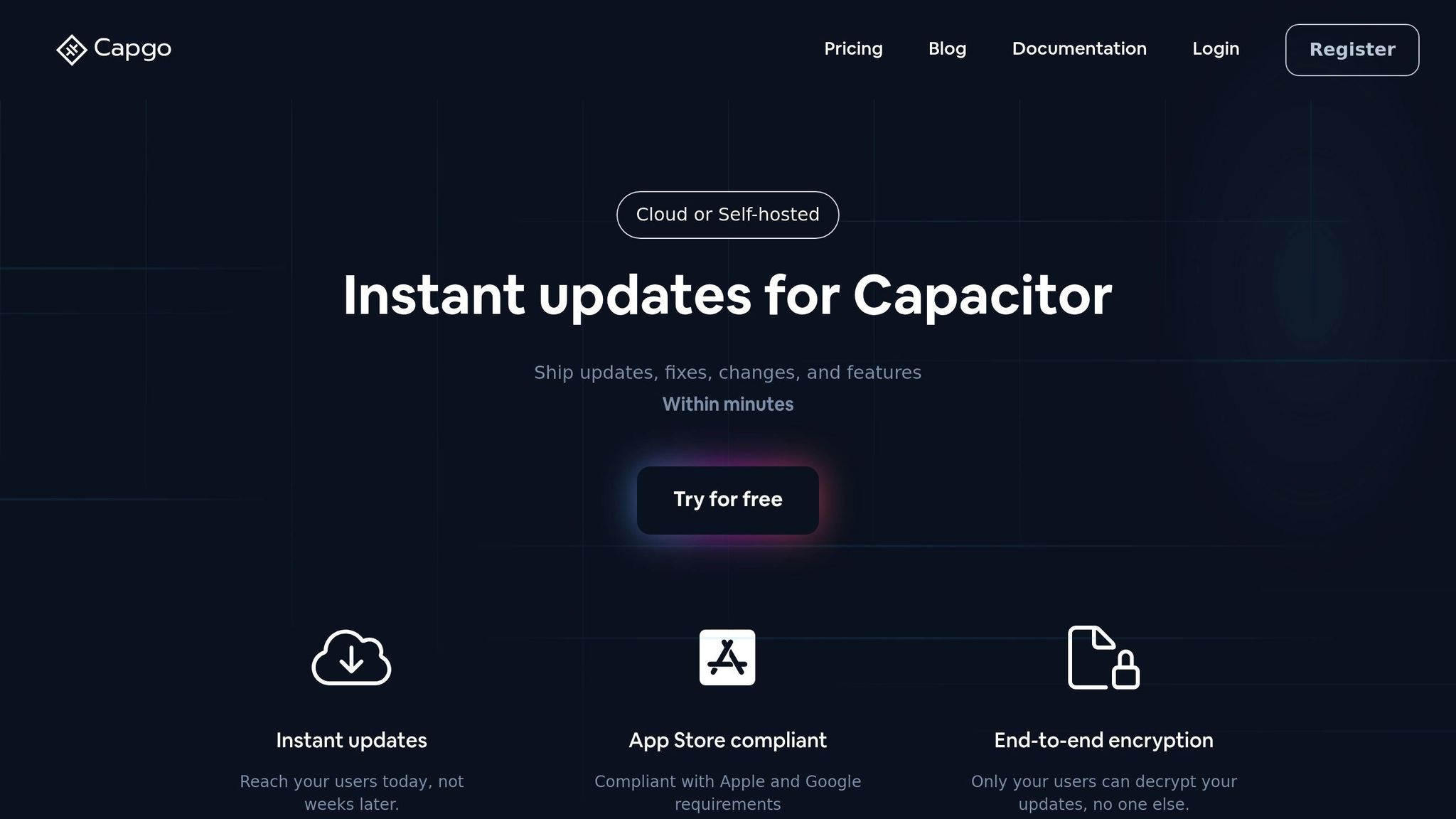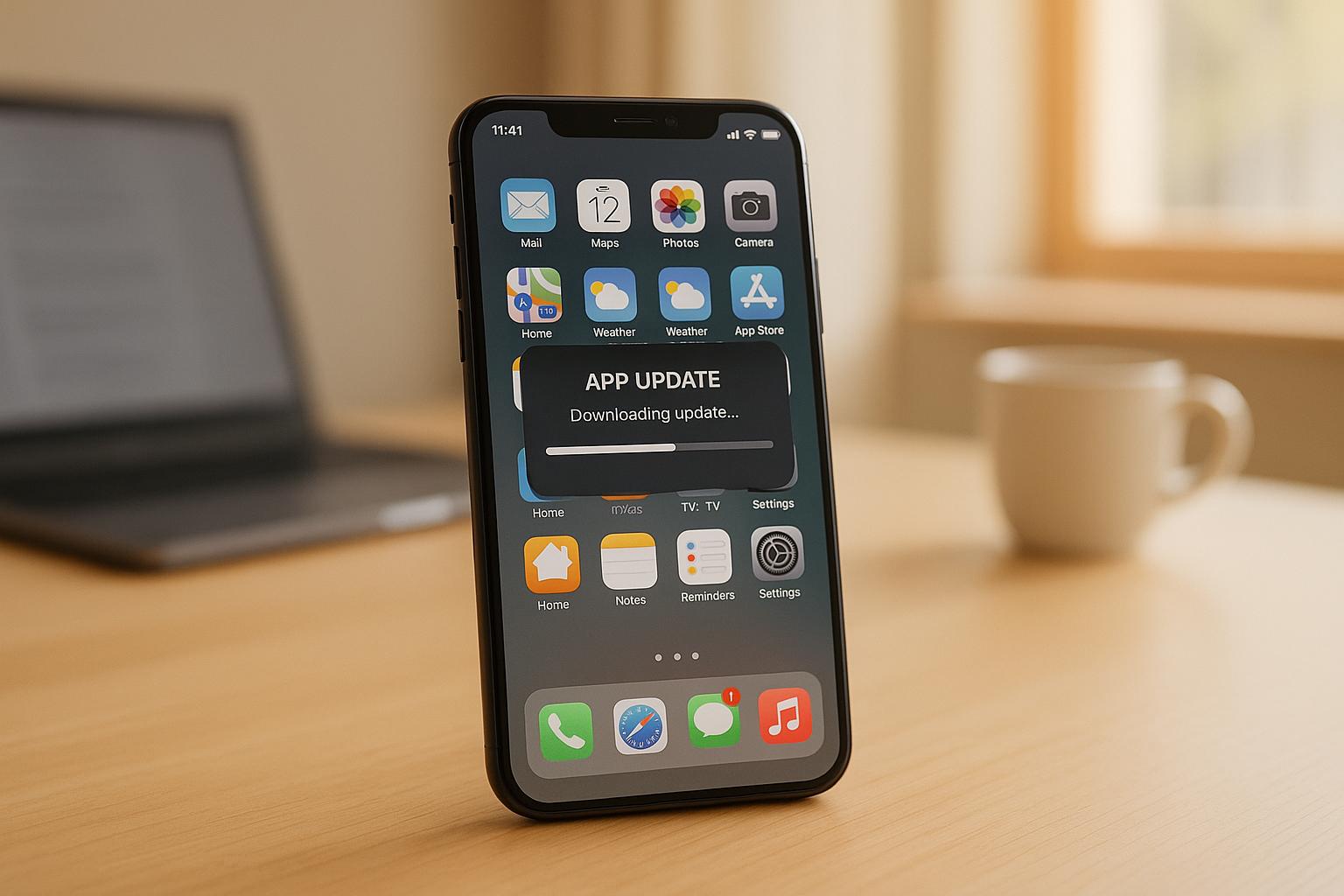Want to update your Capacitor app instantly without app store delays? Over-the-air (OTA) updates let you deliver new features, fix bugs, and address security issues directly to users - no app store review required. Here’s what you need to know:
- Why OTA Updates Matter: Skip app store reviews (2–7 days) and reach 95% of users within 24 hours.
- Best Use Cases: Real-time fixes, adapting APIs, and staying ahead of security threats.
- Capgo’s Advantage: 95% update success rate, 114ms global download speed, and one-click rollbacks.
| Update Method | Speed | Review Required | Best For |
|---|---|---|---|
| App Store Updates | 2–7 days | Yes | Major changes |
| Web Updates | Immediate | No | Minor fixes |
| OTA Platforms | Minutes | No | Feature updates |
Capgo leads the way with secure, fast, and scalable OTA solutions for Capacitor apps. Whether you’re a small team or a large enterprise, it simplifies updates, saves time, and ensures compliance with app store guidelines. Ready to streamline your updates?
1. Capgo Platform Features

Launched in 2022, Capgo has quickly established itself as a top-tier OTA update solution for Capacitor apps. It boasts an impressive 95% update rate within 24 hours, achieved through a global CDN capable of delivering a 5MB bundle in just 114ms, with an average API response time of 434ms [1].
The platform prioritizes security and compliance, offering:
- End-to-end encryption to safeguard all updates
- Full compliance with Apple and Google Play Store guidelines
- One-click rollback to revert to any previous version effortlessly
- Advanced distribution channels for beta testing and controlled rollouts
For enterprises managing large-scale deployments, Capgo ensures reliable performance with key metrics:
| Feature | Performance Metric | Benefit |
|---|---|---|
| Global CDN | 114ms download speed | Fast and efficient updates |
| Update Success Rate | 82% worldwide | Consistent delivery across regions |
| Active Users | 2.0K+ production apps | Proven scalability for enterprises |
| Storage Efficiency | Smart differential updates | Reduces bandwidth consumption |
Capgo’s seamless CI/CD integration simplifies update workflows, contributing to its impressive delivery of 1,747.6 billion updates to date [1].
For organizations with specific needs, Capgo offers flexible hosting options:
- Cloud-hosted setup for quick deployment
- Self-hosted solutions for greater control
- Custom channel configurations for staged rollouts
- Advanced analytics and error tracking to monitor performance
As an open-source platform with 594 GitHub stars [1], Capgo emphasizes transparency and welcomes community contributions. This approach not only enhances reliability but also supports advanced features like detailed analytics and staged deployment strategies, making it a trusted choice for enterprise use.
2. Built-in Capacitor Update Options
Capacitor’s native framework supports essential update capabilities by utilizing web content updates, ensuring compliance with both Apple App Store and Google Play Store guidelines [3]. These built-in features serve as a starting point for implementing over-the-air (OTA) updates in Capacitor applications.
Capacitor apps, which blend web technologies with native functionality [3], come equipped with features like:
| Feature | Implementation | Security |
|---|---|---|
| Web Content Updates | Native browser engine | TLS 1.3 encryption |
| Native SDK Integration | Direct API access | Platform-specific verifications |
| Plugin Architecture | Modular design | Isolated contexts |
Given this setup, robust security measures are essential. Implementing tools like device verification, update authentication, and strict version control helps maintain the integrity of updates.
However, ensuring secure updates is only part of the equation. A well-thought-out deployment strategy is equally important, especially for enterprise-level applications. Consider the following:
- Staged Deployment: Start updates with internal testing, then gradually expand to larger user groups. This approach helps identify and address potential issues before a full-scale release.
- Version Management: Keep track of deployed updates and have rollback procedures in place to maintain system stability if something goes wrong.
- Performance Optimization: Leverage native SDK integration [4] to ensure efficient use of resources.
Capacitor’s built-in tools provide a reliable framework for basic update functionality. Their modular design also makes it easy to integrate native SDKs and custom plugins via a simple API [4]. While these built-in options cover the essentials, platforms like Capgo can extend these capabilities with advanced enterprise-grade features.
Key Differences Between Update Methods
When comparing update methods, specialized platforms clearly surpass native options in several important areas.
Here’s a detailed breakdown of how they differ:
| Feature | Native Capacitor Updates | Capgo Platform |
|---|---|---|
| Deployment Speed | 2–7 days (app store review) | Minutes to hours |
| Update Distribution | Manual user approval needed | Automatic background updates |
| Success Rate | Variable (user-dependent) | 95% within 24 hours |
| Bandwidth Usage | Full app download required | Only changed content |
| Security Level | Standard HTTPS | End-to-end encryption |
| Analytics | Basic installation metrics | Real-time update tracking |
| Rollback Options | Requires new submission | One-click instant rollback |
| Distribution Control | Limited targeting options | Channel-based targeting |
These distinctions have a direct influence on update speed, reliability, and security in practical scenarios.
“Capgo is a must-have tool for developers who want to be more productive. Avoiding review for bug fixes is golden.” - Bessie Cooper [1]
The difference in efficiency becomes especially clear during rapid deployment situations. Traditional app store updates require a full review cycle, which can delay critical fixes. In contrast, over-the-air (OTA) solutions, like Capgo, allow for immediate responses to urgent issues. In fact, Capgo achieves an impressive 82% global success rate for updates [1].
Modern OTA platforms also integrate effortlessly with CI/CD pipelines, streamlining deployments. They offer advanced user management and permission controls, providing greater operational flexibility compared to traditional methods. These features enhance the efficiency gains discussed earlier.
Performance optimization also varies significantly. Native updates often involve downloading the entire app again, while advanced OTA solutions focus on sending only the changed content. This reduces bandwidth consumption and shortens update times, which is particularly beneficial for organizations handling large-scale deployments in diverse network environments.
Security is another area where specialized platforms stand out. While native updates rely on standard web security protocols, platforms like Capgo add extra layers of protection, ensuring a more secure experience.
These differences highlight the progression from basic update methods to more sophisticated deployment solutions, each tailored to meet specific needs and challenges effectively.
Conclusion
Choosing the right OTA method hinges on factors like team size, specific needs, and available resources. For smaller teams and independent developers, specialized OTA platforms often outshine native methods. Cloud-based solutions, such as Capgo, strike a great balance by offering fast deployment capabilities, making them ideal for teams that need to roll out updates quickly and efficiently.
For medium to large enterprises, more comprehensive OTA solutions are a better fit. These platforms provide advanced security features and detailed control over updates. One enterprise user shared their experience:
“We rolled out Capgo OTA updates in production for our user base of +5000. We’re seeing very smooth operation almost all our users are upto date within minutes of the OTA being deployed to @Capgo.” - colenso [1]
This example highlights how effective OTA platforms help enterprises manage large-scale updates with precision and ease.
Agile teams also benefit significantly from these platforms, thanks to simplified version management and secure, automatic deployments [2]. As the industry moves toward more reliable and proven solutions, the focus shifts to ensuring long-term stability when selecting a platform.
When evaluating OTA methods, teams should pay attention to key factors such as:
- Global API response times
- Update delivery success rates
- CI/CD pipeline integration
- Security compliance standards
FAQs
::: faq
How do OTA updates improve security for Capacitor apps compared to traditional app store updates?
Over-the-air (OTA) updates bring a major advantage to Capacitor apps by allowing developers to push out critical fixes and security patches immediately. There’s no need to wait for app store reviews, which means vulnerabilities can be addressed as soon as they’re discovered. This quick response greatly reduces the risk of potential security threats.
Another key benefit is that OTA updates ensure every user is running the same secure version of the app. This consistency eliminates gaps in protection and reduces the chances of outdated versions exposing users to risks. By keeping user data safe and staying aligned with security standards, OTA updates have become a crucial part of modern app development. :::
::: faq
What makes Capgo a better choice for OTA updates in Capacitor apps compared to native options?
Capgo is an excellent option for over-the-air (OTA) updates, delivering instant updates without the hassle of waiting for app store approvals. With end-to-end encryption, it ensures updates are secure and offers robust tools like rollback capabilities, error tracking, and user-specific update management.
Being an open-source platform, Capgo works effortlessly with CI/CD workflows, streamlining the update process for developers. This not only speeds up deployment but also gives developers more control and flexibility over app updates - all while staying compliant with Apple and Android guidelines. :::
::: faq
What are the advantages of Capgo’s one-click rollback feature for enterprises during large-scale updates?
Enterprises stand to gain a lot from Capgo’s one-click rollback feature, especially during large-scale updates. If something goes wrong, teams can swiftly revert to a stable version, keeping downtime to a minimum, easing user frustrations, and ensuring business operations stay on track.
This feature also enables controlled rollouts and simplifies error tracking, giving teams the confidence to manage updates without worrying about major disruptions. It’s a powerful way to maintain a smooth user experience, even when dealing with complex deployments. :::




